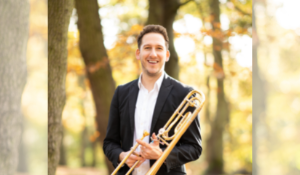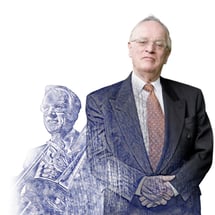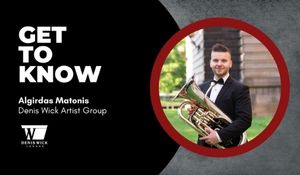A New Technique for Fixing Technique Issues

.png?width=300&name=Matt%20(1).png) Playing by ear and working in groups form the foundations of both my teaching and practice. In this article I look to explain why I think it holds so much value and how I think anyone can improve their enjoyment of playing with some time spent playing without music each week, with even more success if you can find others to play with too.
Playing by ear and working in groups form the foundations of both my teaching and practice. In this article I look to explain why I think it holds so much value and how I think anyone can improve their enjoyment of playing with some time spent playing without music each week, with even more success if you can find others to play with too.
Often when watching a jazz musician play they improvise with such flair and dexterity that I sit and listen in awe of their technical ability. But the reality is that the instrument is simply their chosen voice to express themselves. They aren’t considering technical difficulties such as joining one note to the next smoothly or the positioning their aperture correctly ahead of a large leap within a phrase. Their thought is on the emotion, the language and the story they want to tell.
Whilst studying with Ian Bousfield he used to talk about having lessons with clarinetists, cellists, conductors before a big performance because they wouldn’t allow technical difficulties to be a barrier to the music making. The combination of this advice and my study of how both improvised and elite musicians practice and perform has helped form my philosophy to teaching and playing.
How can we adopt an approach to playing with the focus more on the end result than the technical demands? What steps do we need to take to feed our confidence to play with a freedom that isn't restricted by techinical barriers?
I believe we can challenge ourselves to think about things more melodically and harmonically rather than technically. Play more by ear, inventing our own exercises to stretch our knowledge and ability, resulting in a greater understanding of our way around the instrument and a more efficient and reliable technical base. If you can constantly strive to know your way around the instrument better with a sound understanding melodically and harmonically through every key then you will find you can perform with a greater freedom. Sight-reading will be significantly improved too along with increased confidence and enjoyment and a whole host of other benefits.
Commonly we wait for a technical difficulty to arise in a solo piece or excerpt then find or create exercises to help us through it. This is a successful short term fix however it puts unnecessary phycological stress on the difficult passage. The focus of the practice is building up to a select moment, no matter how well prepared we are, it’s still “the hard bit”.
The number of times I’ve heard students lack clarity and composure at the end of the first phase of the David Concertino. So we break if up, practice the first beat, then the next, then add it together… fine. But really the best solution is to implement major and dominant 7th exercises into your weekly practice through every key so the bar itself isn’t remotely stressful in the first place.
What is the purpose of a warm up or a practice session? To reach the level we need? To hit the targets our teachers have set out for us? Or to simply keep ourselves in shape?
What if the narrative was flipped to say that every week at least 15-25% of your practice and warm up time is designated to betterering your knowledge of your way around your instrument. Playing multiple harmonic exercises without music (focusing on positive airflow) to grow your confidence playing melodically through all 12 keys. The narrative now starts to become "prepare to succeed rather than wait to fail".
The Plan
“How do I begin this process? It’s different way of working to my trusted exercise books.”
I was lucky that Peter Gane drilled my scales into me on NYO courses as a child so I had a good base and that exactly where we need to start. However, there is absolutely no need to complicate things until you are very happy with the process. Every step of this should feed your confidence rather than dent it.
Considering the following at all times:
- Always play with your best sound
- Aim for efficient playing - achieved by focusing on positive airflow through a focused and consistent embuchure
- Play with a melodic line as if every exercise is the best tune you’ve ever heard
Then when happy you play with an even sound in an efficient way...
- Can I develop an exercise to get to know my way around the instrument better?
For the first couple of weeks just focus on major scales and arpeggios. Aim to master one octave major arpeggios in every key with those few key principles in place. Your air must be constant with good direction, forming a wave shape through the phrase. In order to gain maximum flexibility we need to be as efficient as possible using one open column of air - get ready to embrace the glissando! If our air shifts or dips between notes it is likely the lips will too, often resulting in too much movement between middle and low register. For all exercises use glissando air with a quick slide unless directed otherwise.
To find the optimum lip position and aperture, increase and decrease the speed and warmth of the air in a wave form without any sudden dips or shifts. The lips naturally won’t open so much in the low register, retaining a focus to the sound and making it easier to slur down and back up to the middle register.
*Struggling to find this feeling - glissando from low Bb to low F in sixth, do this whilst concentrating on the warmth of the air increasing as you go down. Do this a few times to see how your lips don’t need to shift. Then do the same but with the F on the trigger. Maintain exactly the same technique. Try harmonic above first if needed (F-C).
In order to gain flexibility we need to become confident changing direction within a slur. The next step is to change the order you play the notes of the arpeggio or scale, keeping the sound just as even as before. These then start to become little melodies, introduce the tongue where appropriate without changing your airflow. Try now choosing a small selections of notes from a major scale, can be as simple as 5/6 notes and transpose this through all twelve keys. A good place to start is the first few notes of Twinkle Twinkle.
As long as you can confidently say your sound is even and full across everything you have played, you have now mastered the principles of the process. It is now up to you to challenge yourself to see how far you can take it.
I always begin every practice session by encouraging vibrations in my lips with mouthpiece buzzing or pitch bending exercises. But following this I’m immediately into melodic playing of exercises by ear.
In a good week I will aim to play patterns or exercises to cover all of my major + minor scales and arpeggios, dominant and diminished 7ths, augmented arpeggios plus often my major and minor pentatonic scales. Challenging myself further by learning progressions round the circle of 5ths and through chord progressions within each key. Trying to finish most practice sessions playing a simple melody through a few different keys.
At the start of the article I mentioned group warm ups yet everything I have spoken about seems like hard-core solo practice. Along with the two ideas at the start, a huge influence to this approach came from my fellow students at the Royal Academy of Music. Denis Wick once said to me "Everyone in the department can do something better than you, find out what it is and copy it". I was fortunate to study alongside some of the finest trombonists in the country and they were the most incredible inspiration to me. By practicing together and learning each others exercises we all improved.
One of the biggest inspirations along my playing journey has been studying alongside and now working with James Buckle (Bass Trombone, Philharmonia). He matched my enthusiasm in developing my playing but with tones of ideas and ridiculous talent. He taught me that two brains are better than one and many of the exercises I still play today derive from the ideas we shared back when we studied. Try to find others who are also interested in this and challenge each other to improve.
This collaborative way of practicing has now filtered into my teaching, every Saturday at Junior RAM we start the day with a trombone warm up. We either pick an area of the technique to focus on or we have a general warm up where we all bring ideas to help stretch our technique whilst preparing for the day. Recently I had a 16 year old play Jesu Joy of Man's Desiring in all 12 keys and a 14 year old suggest my arpeggio exercise wasn't hard enough because I missed out the dominant 7th despite having both augmented and diminished already in there. If those two things don't sum up the impact this mentality of learning your way around the instrument harmonically (with the freedom of the study book left to one side) can have on a player's ambition, confidence and work ethic then I don't know what will.
By following this approach you will start to see many benefits. On a basic level we confidently play short melodies all the time which is enjoyable (and really encourages positive airflow) and on a sophisticated level we build a foundation to our playing of sound harmonic knowledge that feeds into our confidence to allows us to perform with a greater freedom. By slowly eliminating technical challenges we can allow the trombone to be the tool to express ourselves not the barier it can be.
Matt Lewis - 2022
Follow up material:
PDF attached - exercises I have recently played to support the article: Download Here
Youtube link to play along warm up recorded for the British Trombone Society: https://youtu.be/EP3_nwkfLzk

Find all our Denis Wick resources in one spot on the Denis Wick app. Download to view videos, clinics, educator resources, podcasts, product information & more!



